warning SUZUKI ERTIGA 2013 1.G User Guide
[x] Cancel search | Manufacturer: SUZUKI, Model Year: 2013, Model line: ERTIGA, Model: SUZUKI ERTIGA 2013 1.GPages: 207, PDF Size: 5.14 MB
Page 29 of 207
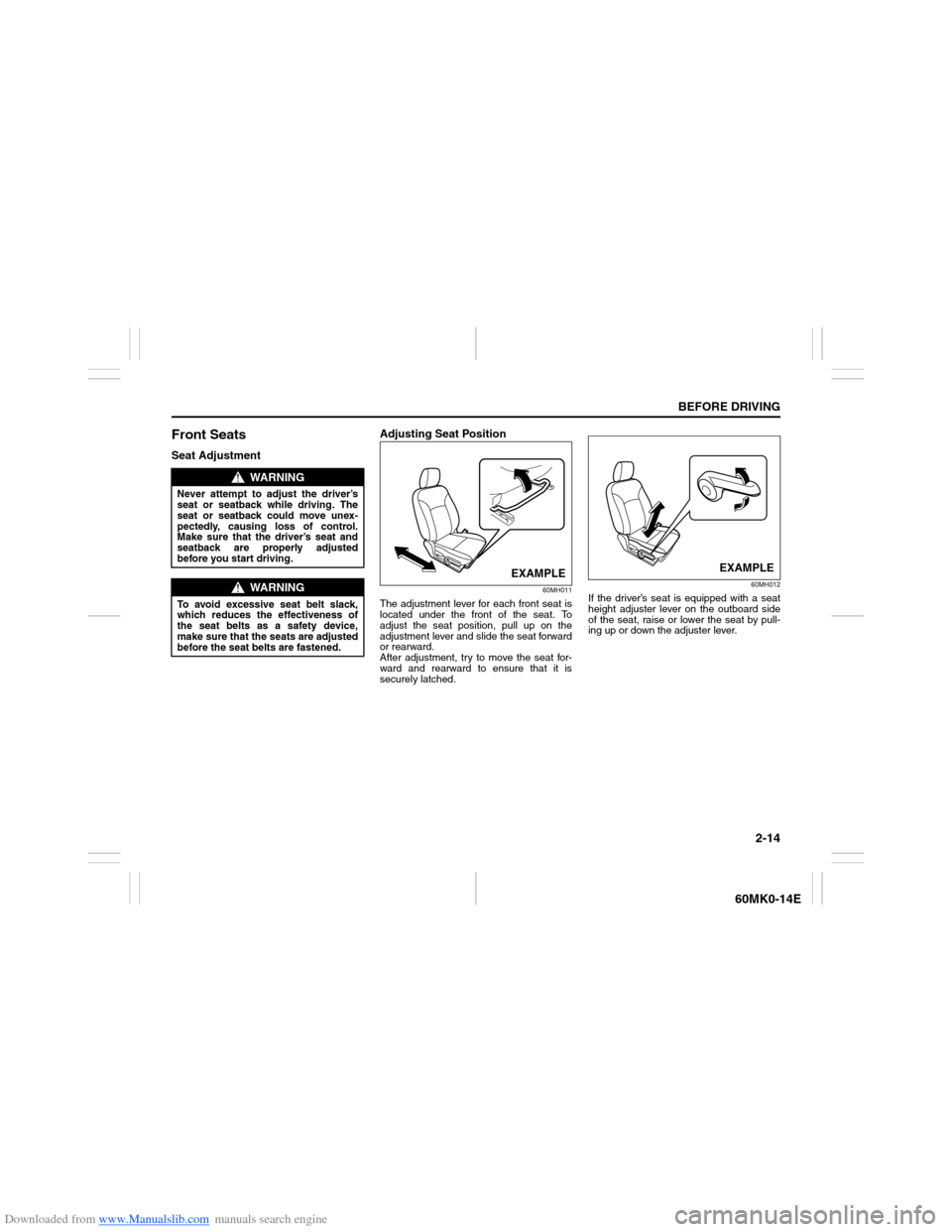
Downloaded from www.Manualslib.com manuals search engine 2-14
BEFORE DRIVING
60MK0-14E
Front SeatsSeat AdjustmentAdjusting Seat Position
60MH011
The adjustment lever for each front seat is
located under the front of the seat. To
adjust the seat position, pull up on the
adjustment lever and slide the seat forward
or rearward.
After adjustment, try to move the seat for-
ward and rearward to ensure that it is
securely latched.
60MH012
If the driver’s seat is equipped with a seat
height adjuster lever on the outboard side
of the seat, raise or lower the seat by pull-
ing up or down the adjuster lever.
WARNING
Never attempt to adjust the driver’s
seat or seatback while driving. The
seat or seatback could move unex-
pectedly, causing loss of control.
Make sure that the driver’s seat and
seatback are properly adjusted
before you start driving.
WARNING
To avoid excessive seat belt slack,
which reduces the effectiveness of
the seat belts as a safety device,
make sure that the seats are adjusted
before the seat belts are fastened.
EXAMPLE
EXAMPLE
Page 30 of 207
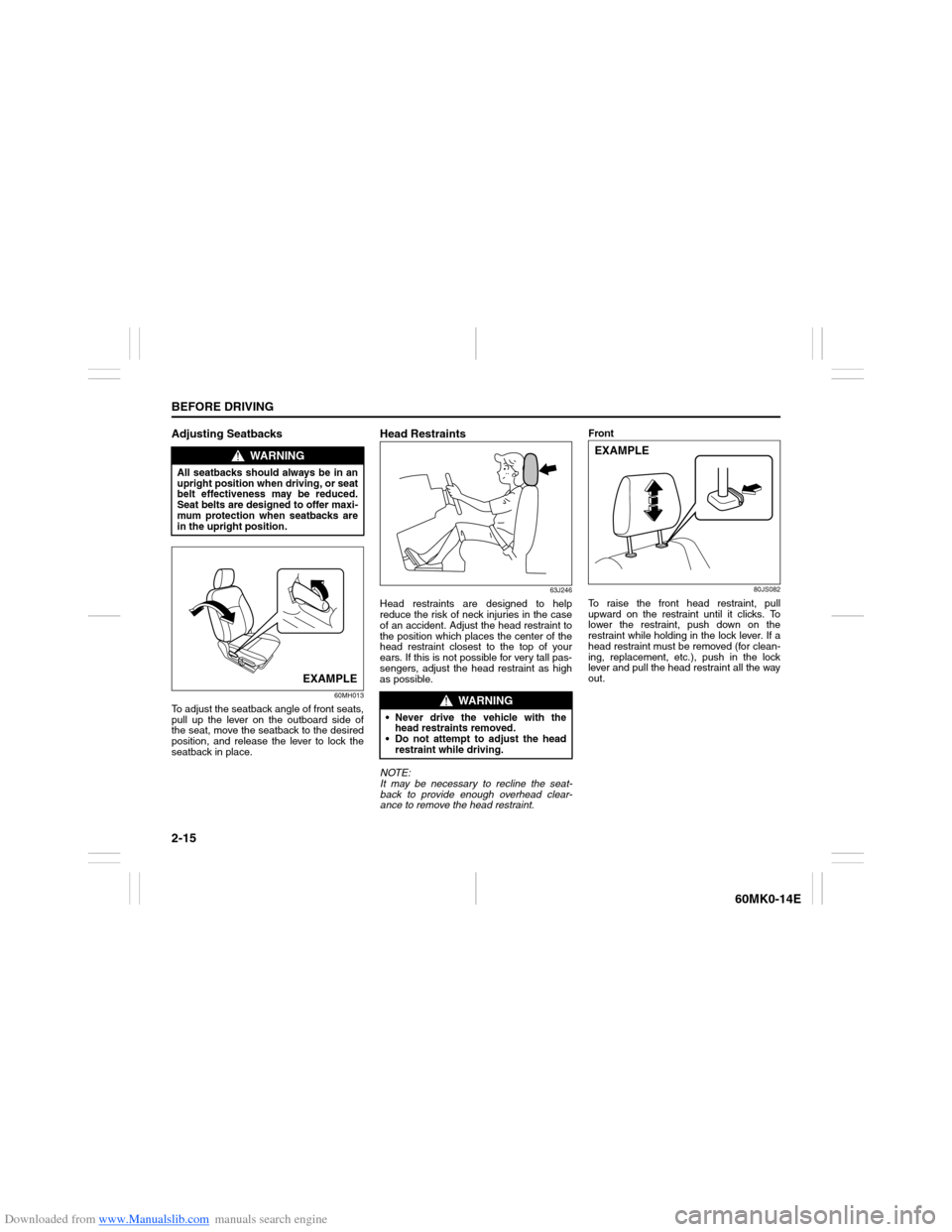
Downloaded from www.Manualslib.com manuals search engine 2-15BEFORE DRIVING
60MK0-14E
Adjusting Seatbacks
60MH013
To adjust the seatback angle of front seats,
pull up the lever on the outboard side of
the seat, move the seatback to the desired
position, and release the lever to lock the
seatback in place.
Head Restraints
63J246
Head restraints are designed to help
reduce the risk of neck injuries in the case
of an accident. Adjust the head restraint to
the position which places the center of the
head restraint closest to the top of your
ears. If this is not possible for very tall pas-
sengers, adjust the head restraint as high
as possible.
NOTE:
It may be necessary to recline the seat-
back to provide enough overhead clear-
ance to remove the head restraint.Front
80JS082
To raise the front head restraint, pull
upward on the restraint until it clicks. To
lower the restraint, push down on the
restraint while holding in the lock lever. If a
head restraint must be removed (for clean-
ing, replacement, etc.), push in the lock
lever and pull the head restraint all the way
out.
WARNING
All seatbacks should always be in an
upright position when driving, or seat
belt effectiveness may be reduced.
Seat belts are designed to offer maxi-
mum protection when seatbacks are
in the upright position.
EXAMPLE
WARNING
Never drive the vehicle with the
head restraints removed.
Do not attempt to adjust the head
restraint while driving.
EXAMPLE
Page 31 of 207
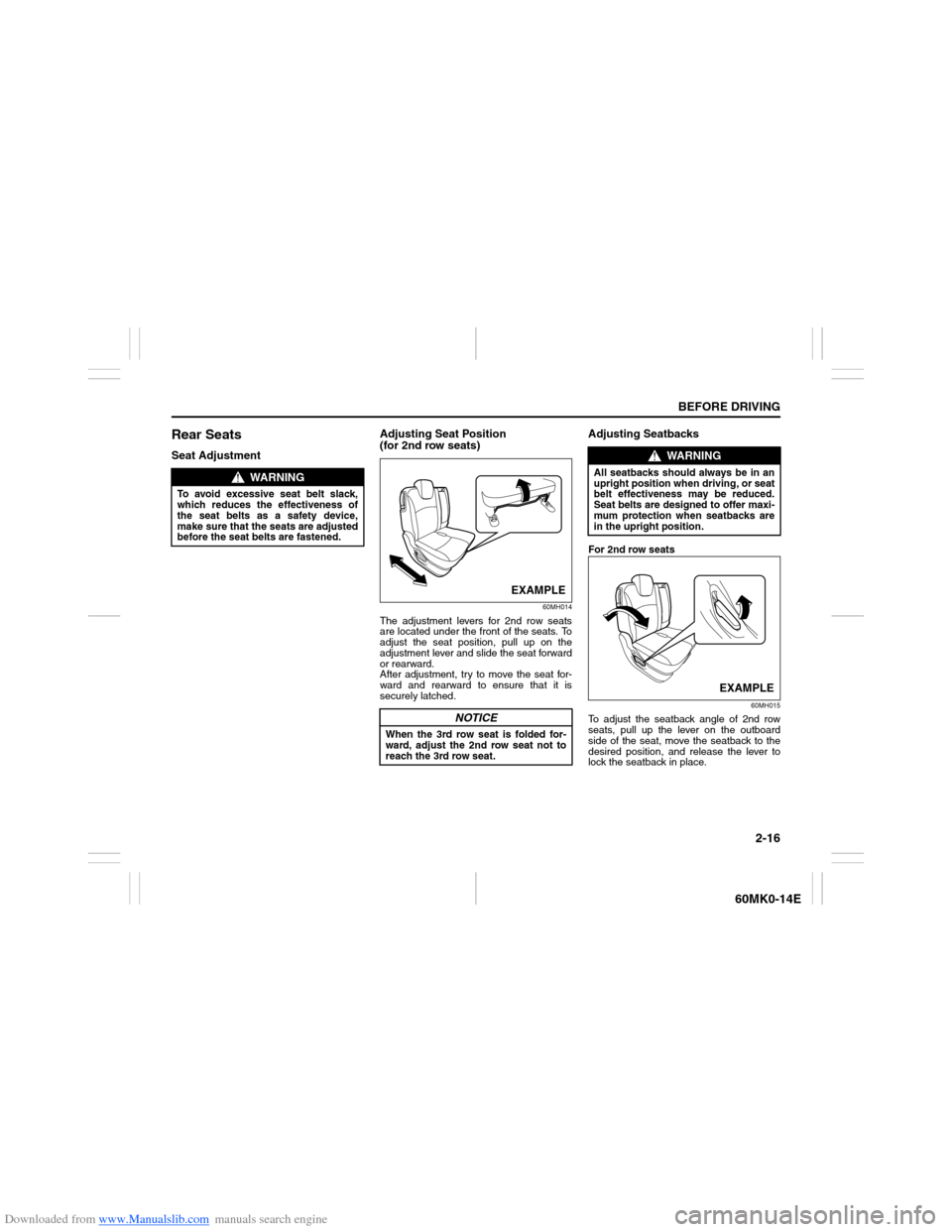
Downloaded from www.Manualslib.com manuals search engine 2-16
BEFORE DRIVING
60MK0-14E
Rear SeatsSeat AdjustmentAdjusting Seat Position
(for 2nd row seats)
60MH014
The adjustment levers for 2nd row seats
are located under the front of the seats. To
adjust the seat position, pull up on the
adjustment lever and slide the seat forward
or rearward.
After adjustment, try to move the seat for-
ward and rearward to ensure that it is
securely latched.
Adjusting SeatbacksFor 2nd row seats
60MH015
To adjust the seatback angle of 2nd row
seats, pull up the lever on the outboard
side of the seat, move the seatback to the
desired position, and release the lever to
lock the seatback in place.
WARNING
To avoid excessive seat belt slack,
which reduces the effectiveness of
the seat belts as a safety device,
make sure that the seats are adjusted
before the seat belts are fastened.
NOTICE
When the 3rd row seat is folded for-
ward, adjust the 2nd row seat not to
reach the 3rd row seat.
EXAMPLE
WARNING
All seatbacks should always be in an
upright position when driving, or seat
belt effectiveness may be reduced.
Seat belts are designed to offer maxi-
mum protection when seatbacks are
in the upright position.
EXAMPLE
Page 32 of 207
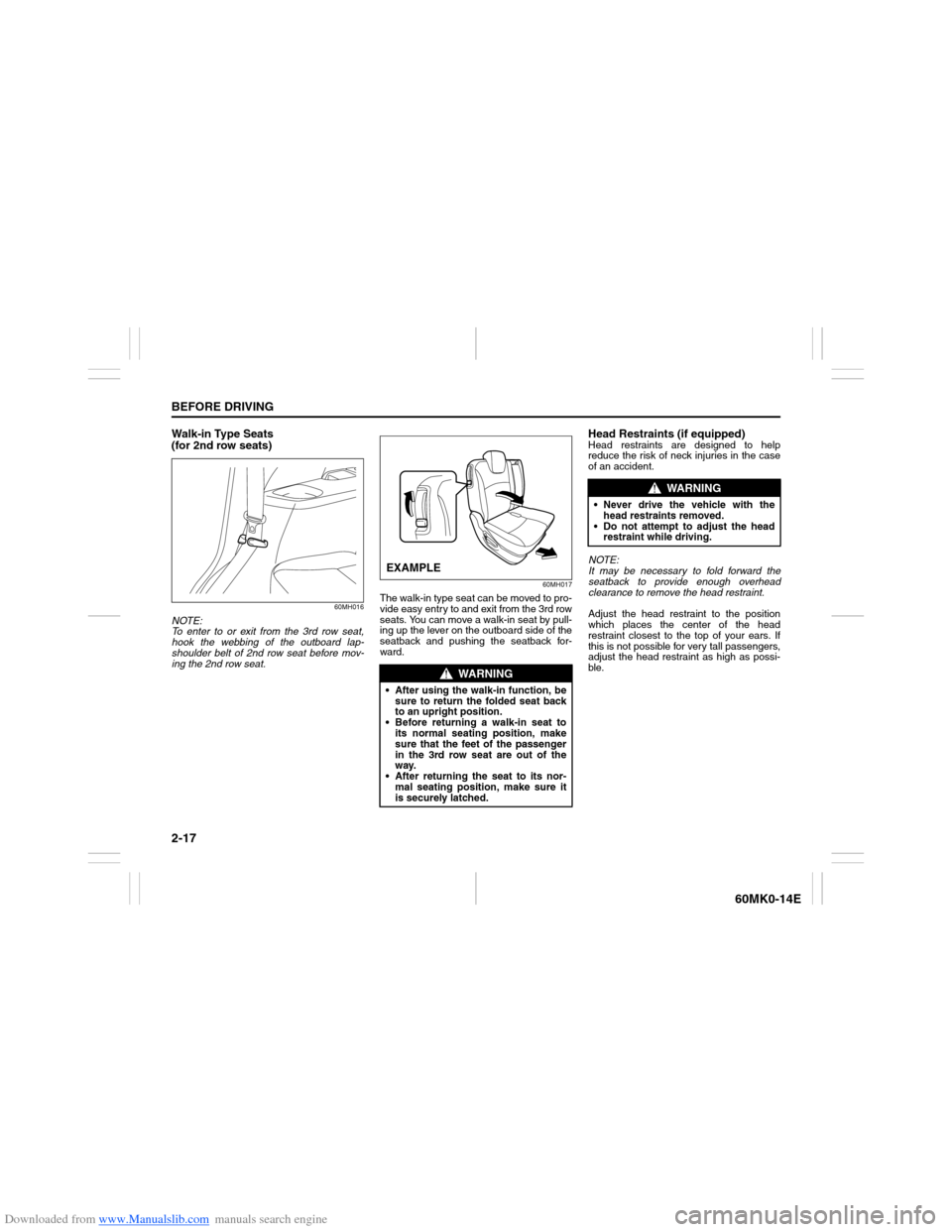
Downloaded from www.Manualslib.com manuals search engine 2-17BEFORE DRIVING
60MK0-14E
Walk-in Type Seats
(for 2nd row seats)
60MH016
NOTE:
To enter to or exit from the 3rd row seat,
hook the webbing of the outboard lap-
shoulder belt of 2nd row seat before mov-
ing the 2nd row seat.
60MH017
The walk-in type seat can be moved to pro-
vide easy entry to and exit from the 3rd row
seats. You can move a walk-in seat by pull-
ing up the lever on the outboard side of the
seatback and pushing the seatback for-
ward.
Head Restraints (if equipped)Head restraints are designed to help
reduce the risk of neck injuries in the case
of an accident.
NOTE:
It may be necessary to fold forward the
seatback to provide enough overhead
clearance to remove the head restraint.
Adjust the head restraint to the position
which places the center of the head
restraint closest to the top of your ears. If
this is not possible for very tall passengers,
adjust the head restraint as high as possi-
ble.
WARNING
After using the walk-in function, be
sure to return the folded seat back
to an upright position.
Before returning a walk-in seat to
its normal seating position, make
sure that the feet of the passenger
in the 3rd row seat are out of the
way.
After returning the seat to its nor-
mal seating position, make sure it
is securely latched.EXAMPLE
WARNING
Never drive the vehicle with the
head restraints removed.
Do not attempt to adjust the head
restraint while driving.
Page 34 of 207
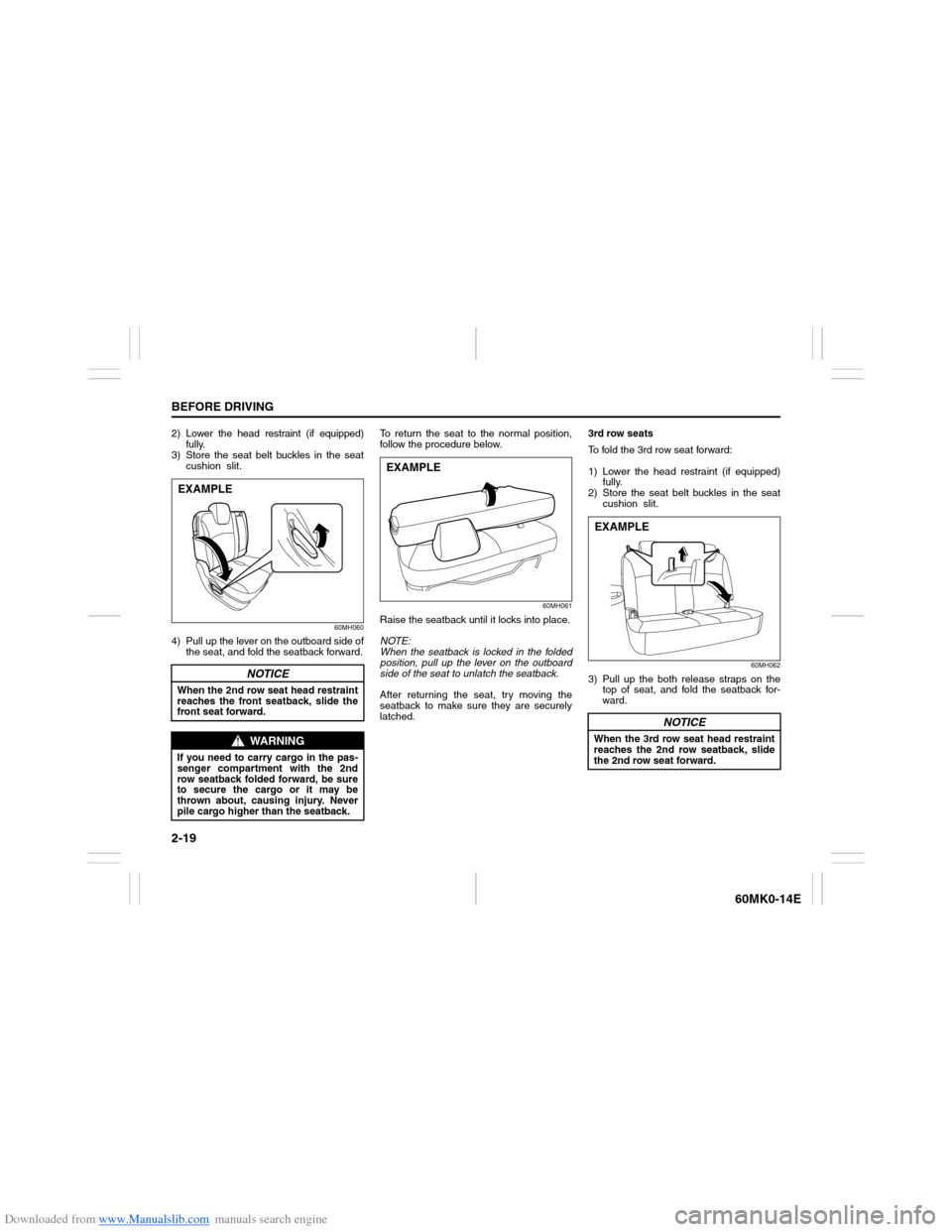
Downloaded from www.Manualslib.com manuals search engine 2-19BEFORE DRIVING
60MK0-14E
2) Lower the head restraint (if equipped)
fully.
3) Store the seat belt buckles in the seat
cushion slit.
60MH060
4) Pull up the lever on the outboard side of
the seat, and fold the seatback forward.To return the seat to the normal position,
follow the procedure below.
60MH061
Raise the seatback until it locks into place.
NOTE:
When the seatback is locked in the folded
position, pull up the lever on the outboard
side of the seat to unlatch the seatback.
After returning the seat, try moving the
seatback to make sure they are securely
latched.3rd row seats
To fold the 3rd row seat forward:
1) Lower the head restraint (if equipped)
fully.
2) Store the seat belt buckles in the seat
cushion slit.
60MH062
3) Pull up the both release straps on the
top of seat, and fold the seatback for-
ward.
NOTICE
When the 2nd row seat head restraint
reaches the front seatback, slide the
front seat forward.
WARNING
If you need to carry cargo in the pas-
senger compartment with the 2nd
row seatback folded forward, be sure
to secure the cargo or it may be
thrown about, causing injury. Never
pile cargo higher than the seatback.EXAMPLE
EXAMPLE
NOTICE
When the 3rd row seat head restraint
reaches the 2nd row seatback, slide
the 2nd row seat forward.EXAMPLE
Page 35 of 207
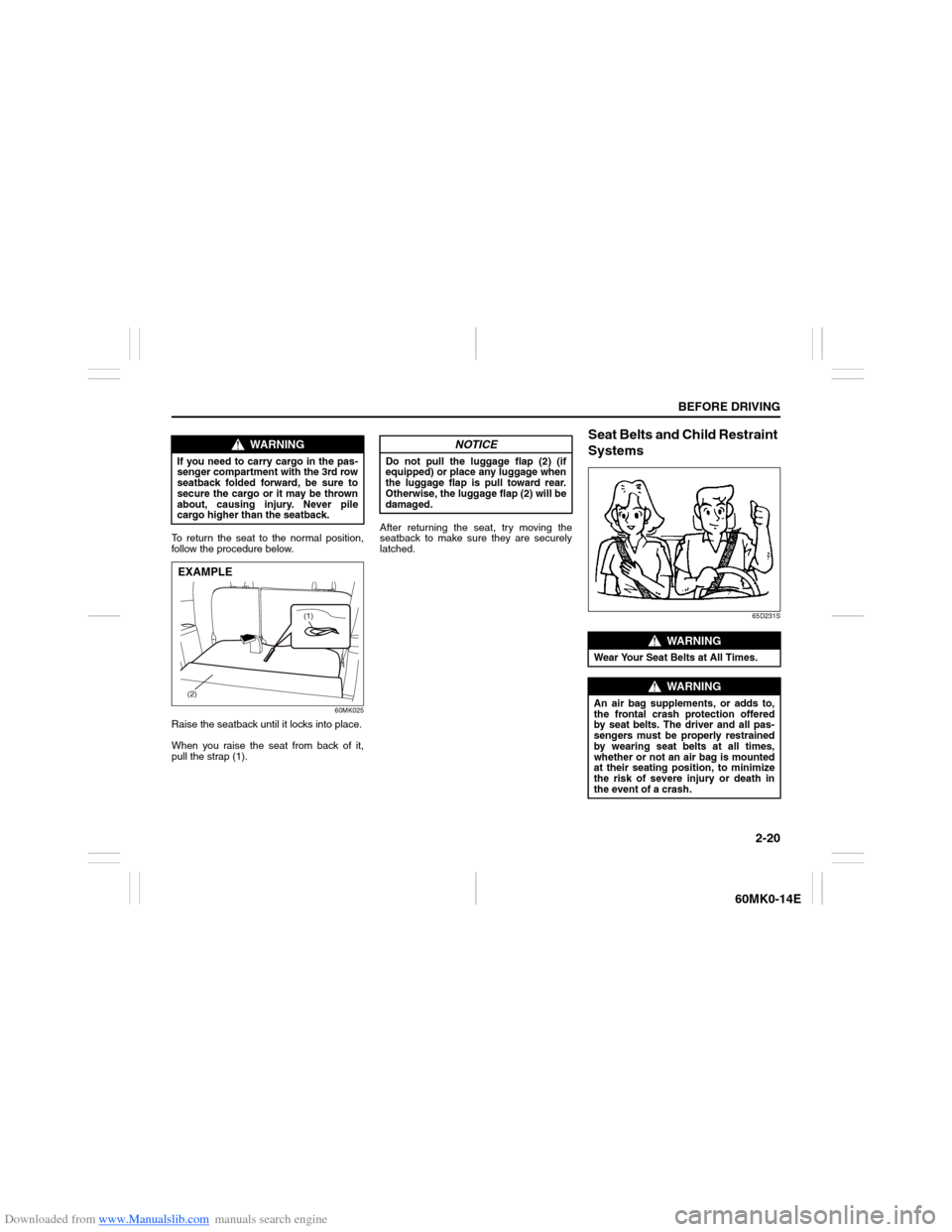
Downloaded from www.Manualslib.com manuals search engine 2-20
BEFORE DRIVING
60MK0-14E
To return the seat to the normal position,
follow the procedure below.
60MK025
Raise the seatback until it locks into place.
When you raise the seat from back of it,
pull the strap (1). After returning the seat, try moving the
seatback to make sure they are securely
latched.
Seat Belts and Child Restraint
Systems
65D231S
WARNING
If you need to carry cargo in the pas-
senger compartment with the 3rd row
seatback folded forward, be sure to
secure the cargo or it may be thrown
about, causing injury. Never pile
cargo higher than the seatback.
(1)
(2)EXAMPLE
NOTICE
Do not pull the luggage flap (2) (if
equipped) or place any luggage when
the luggage flap is pull toward rear.
Otherwise, the luggage flap (2) will be
damaged.
WARNING
Wear Your Seat Belts at All Times.
WARNING
An air bag supplements, or adds to,
the frontal crash protection offered
by seat belts. The driver and all pas-
sengers must be properly restrained
by wearing seat belts at all times,
whether or not an air bag is mounted
at their seating position, to minimize
the risk of severe injury or death in
the event of a crash.
Page 36 of 207
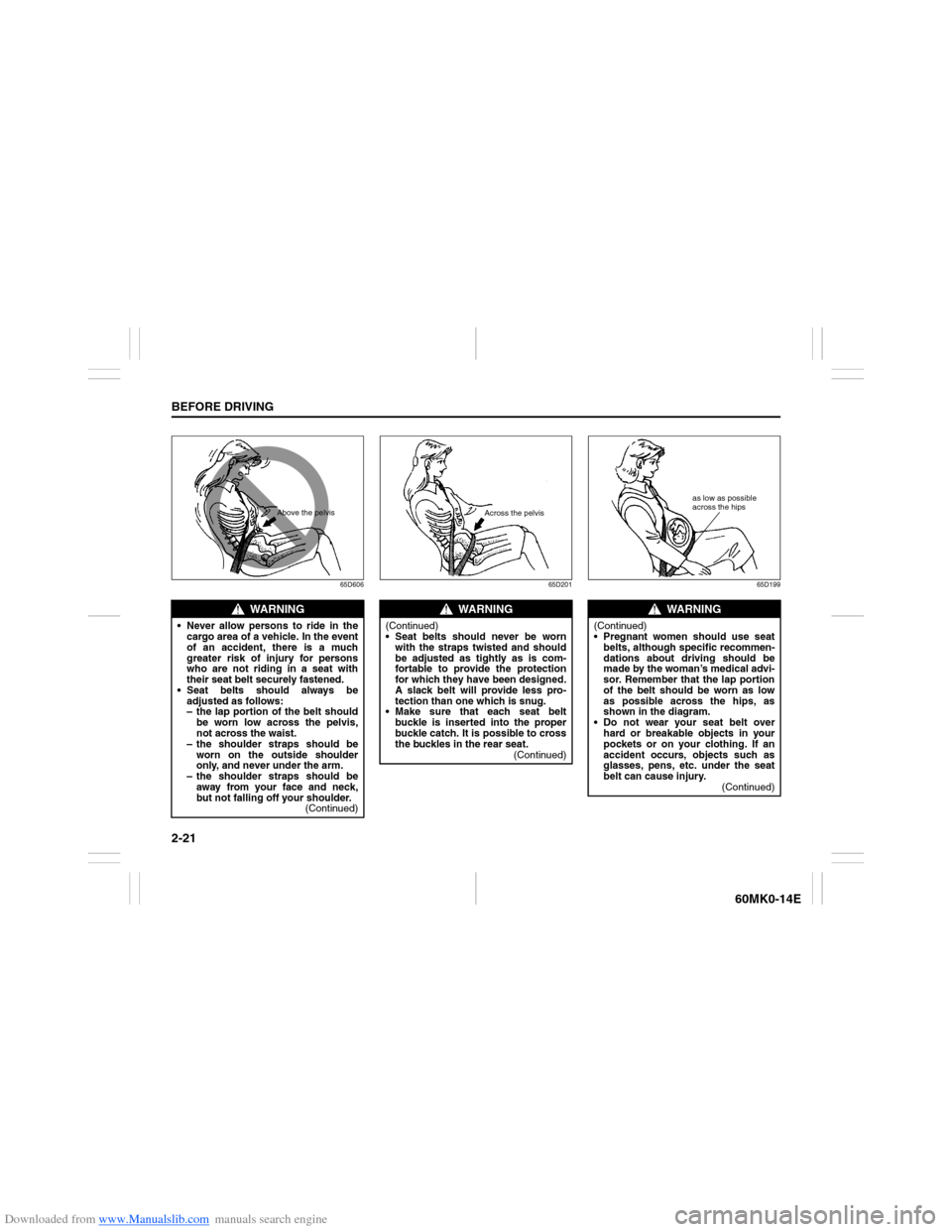
Downloaded from www.Manualslib.com manuals search engine 2-21BEFORE DRIVING
60MK0-14E
65D606 65D201 65D199
WARNING
Never allow persons to ride in the
cargo area of a vehicle. In the event
of an accident, there is a much
greater risk of injury for persons
who are not riding in a seat with
their seat belt securely fastened.
Seat belts should always be
adjusted as follows:
– the lap portion of the belt should
be worn low across the pelvis,
not across the waist.
– the shoulder straps should be
worn on the outside shoulder
only, and never under the arm.
– the shoulder straps should be
away from your face and neck,
but not falling off your shoulder.
(Continued)
Above the pelvis
WARNING
(Continued)
Seat belts should never be worn
with the straps twisted and should
be adjusted as tightly as is com-
fortable to provide the protection
for which they have been designed.
A slack belt will provide less pro-
tection than one which is snug.
Make sure that each seat belt
buckle is inserted into the proper
buckle catch. It is possible to cross
the buckles in the rear seat.
(Continued)
Across the pelvis
WARNING
(Continued)
Pregnant women should use seat
belts, although specific recommen-
dations about driving should be
made by the woman’s medical advi-
sor. Remember that the lap portion
of the belt should be worn as low
as possible across the hips, as
shown in the diagram.
Do not wear your seat belt over
hard or breakable objects in your
pockets or on your clothing. If an
accident occurs, objects such as
glasses, pens, etc. under the seat
belt can cause injury.
(Continued)
as low as possible
across the hips
Page 37 of 207
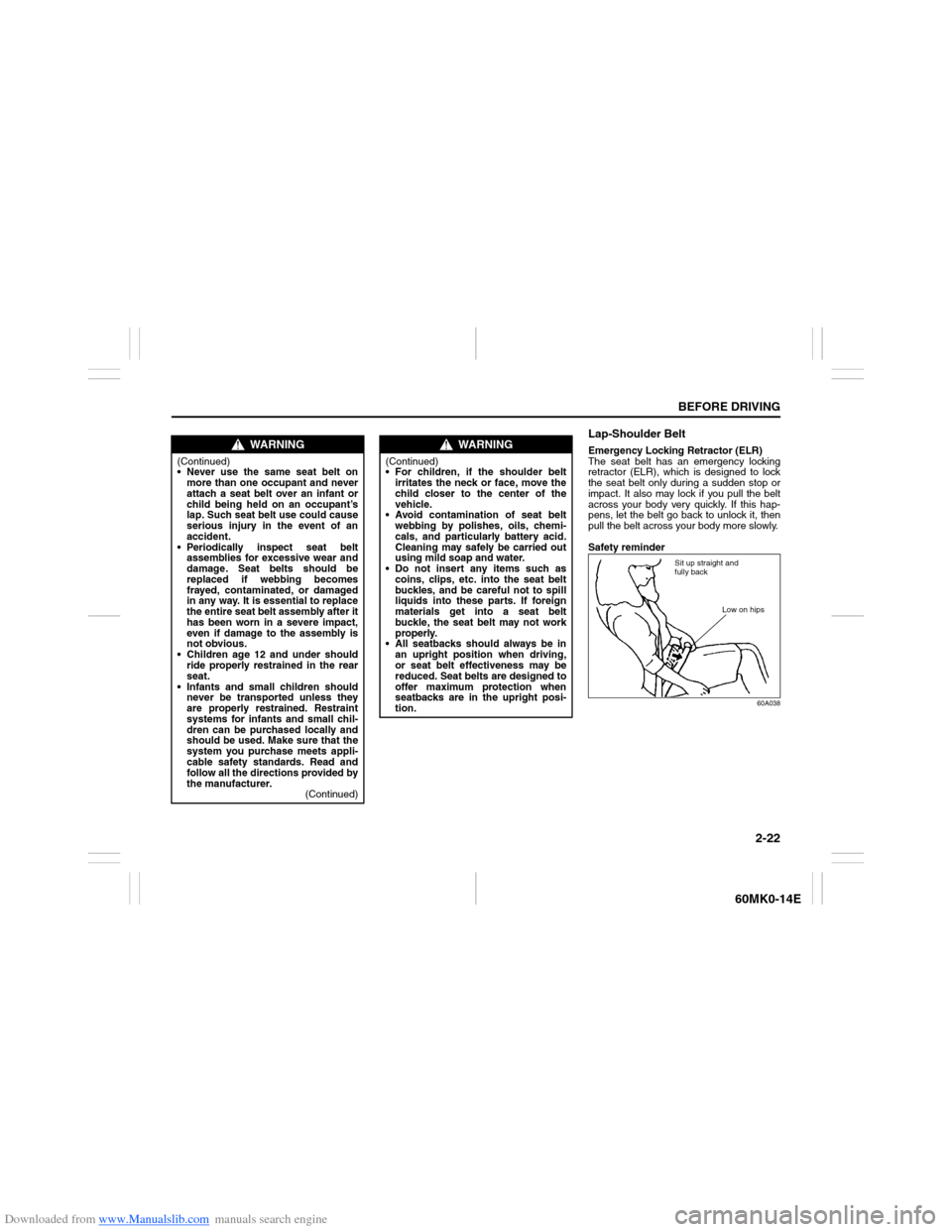
Downloaded from www.Manualslib.com manuals search engine 2-22
BEFORE DRIVING
60MK0-14E
Lap-Shoulder BeltEmergency Locking Retractor (ELR)
The seat belt has an emergency locking
retractor (ELR), which is designed to lock
the seat belt only during a sudden stop or
impact. It also may lock if you pull the belt
across your body very quickly. If this hap-
pens, let the belt go back to unlock it, then
pull the belt across your body more slowly.
Safety reminder
60A038
WARNING
(Continued)
Never use the same seat belt on
more than one occupant and never
attach a seat belt over an infant or
child being held on an occupant’s
lap. Such seat belt use could cause
serious injury in the event of an
accident.
Periodically inspect seat belt
assemblies for excessive wear and
damage. Seat belts should be
replaced if webbing becomes
frayed, contaminated, or damaged
in any way. It is essential to replace
the entire seat belt assembly after it
has been worn in a severe impact,
even if damage to the assembly is
not obvious.
Children age 12 and under should
ride properly restrained in the rear
seat.
Infants and small children should
never be transported unless they
are properly restrained. Restraint
systems for infants and small chil-
dren can be purchased locally and
should be used. Make sure that the
system you purchase meets appli-
cable safety standards. Read and
follow all the directions provided by
the manufacturer.
(Continued)
WARNING
(Continued)
For children, if the shoulder belt
irritates the neck or face, move the
child closer to the center of the
vehicle.
Avoid contamination of seat belt
webbing by polishes, oils, chemi-
cals, and particularly battery acid.
Cleaning may safely be carried out
using mild soap and water.
Do not insert any items such as
coins, clips, etc. into the seat belt
buckles, and be careful not to spill
liquids into these parts. If foreign
materials get into a seat belt
buckle, the seat belt may not work
properly.
All seatbacks should always be in
an upright position when driving,
or seat belt effectiveness may be
reduced. Seat belts are designed to
offer maximum protection when
seatbacks are in the upright posi-
tion.
Sit up straight and
fully back
Low on hips
Page 40 of 207
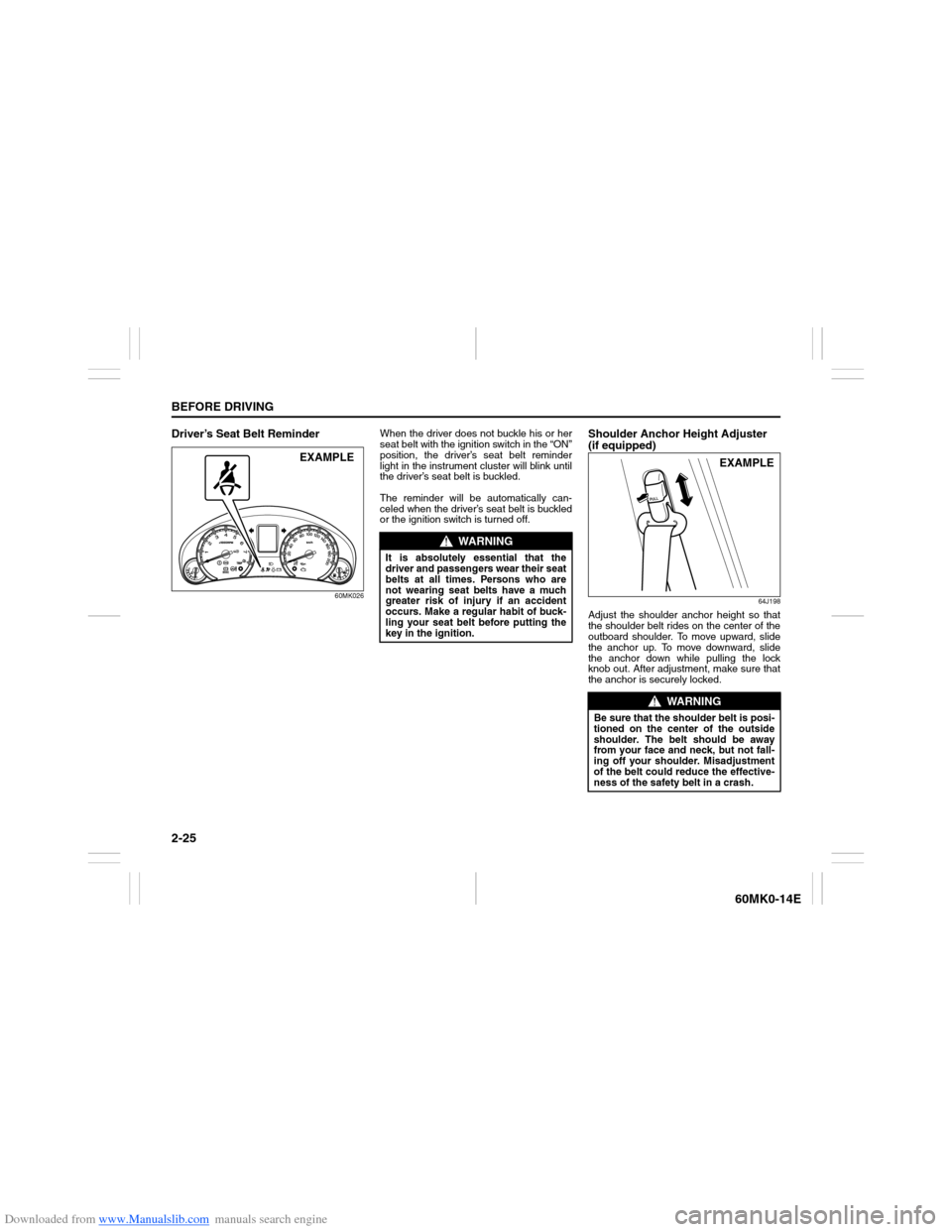
Downloaded from www.Manualslib.com manuals search engine 2-25BEFORE DRIVING
60MK0-14E
Driver’s Seat Belt Reminder
60MK026
When the driver does not buckle his or her
seat belt with the ignition switch in the “ON”
position, the driver’s seat belt reminder
light in the instrument cluster will blink until
the driver’s seat belt is buckled.
The reminder will be automatically can-
celed when the driver’s seat belt is buckled
or the ignition switch is turned off.
Shoulder Anchor Height Adjuster
(if equipped)
64J198
Adjust the shoulder anchor height so that
the shoulder belt rides on the center of the
outboard shoulder. To move upward, slide
the anchor up. To move downward, slide
the anchor down while pulling the lock
knob out. After adjustment, make sure that
the anchor is securely locked.
EXAMPLE
WARNING
It is absolutely essential that the
driver and passengers wear their seat
belts at all times. Persons who are
not wearing seat belts have a much
greater risk of injury if an accident
occurs. Make a regular habit of buck-
ling your seat belt before putting the
key in the ignition.
WARNING
Be sure that the shoulder belt is posi-
tioned on the center of the outside
shoulder. The belt should be away
from your face and neck, but not fall-
ing off your shoulder. Misadjustment
of the belt could reduce the effective-
ness of the safety belt in a crash.
EXAMPLE
Page 41 of 207
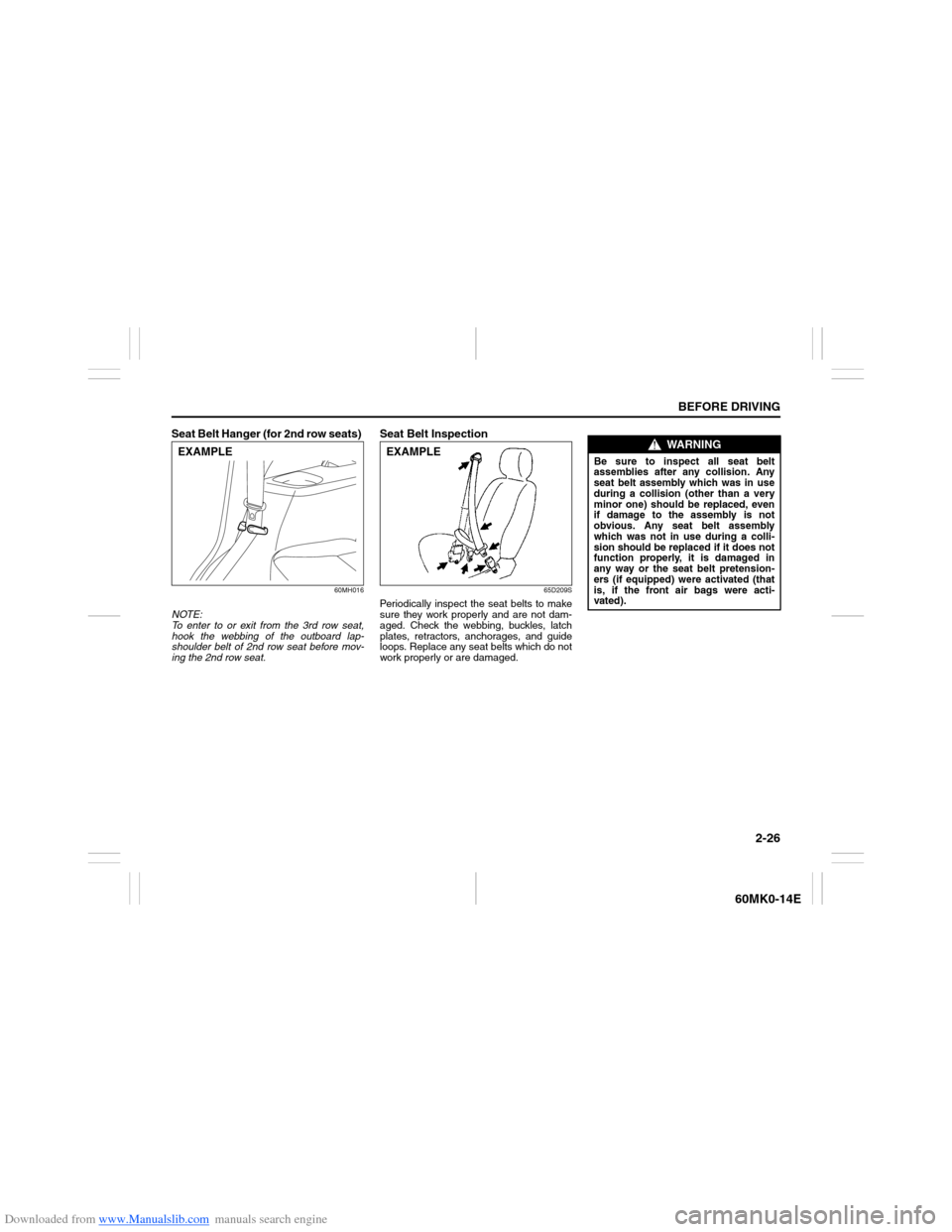
Downloaded from www.Manualslib.com manuals search engine 2-26
BEFORE DRIVING
60MK0-14E
Seat Belt Hanger (for 2nd row seats)
60MH016
NOTE:
To enter to or exit from the 3rd row seat,
hook the webbing of the outboard lap-
shoulder belt of 2nd row seat before mov-
ing the 2nd row seat.
Seat Belt Inspection
65D209S
Periodically inspect the seat belts to make
sure they work properly and are not dam-
aged. Check the webbing, buckles, latch
plates, retractors, anchorages, and guide
loops. Replace any seat belts which do not
work properly or are damaged.
EXAMPLE
EXAMPLE
WARNING
Be sure to inspect all seat belt
assemblies after any collision. Any
seat belt assembly which was in use
during a collision (other than a very
minor one) should be replaced, even
if damage to the assembly is not
obvious. Any seat belt assembly
which was not in use during a colli-
sion should be replaced if it does not
function properly, it is damaged in
any way or the seat belt pretension-
ers (if equipped) were activated (that
is, if the front air bags were acti-
vated).